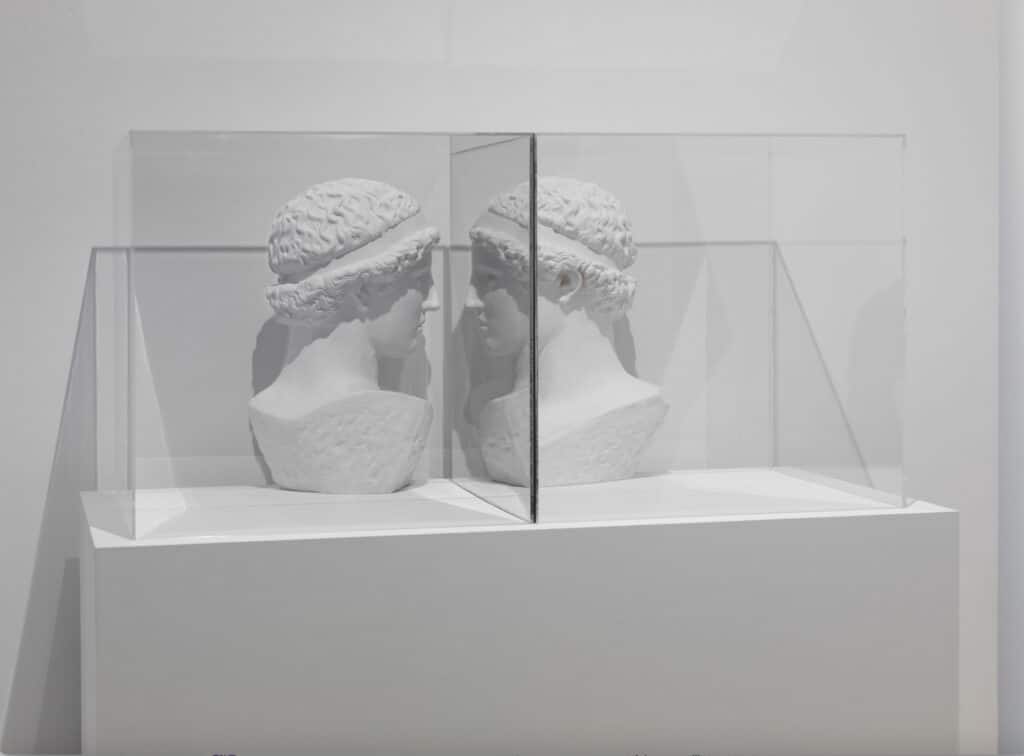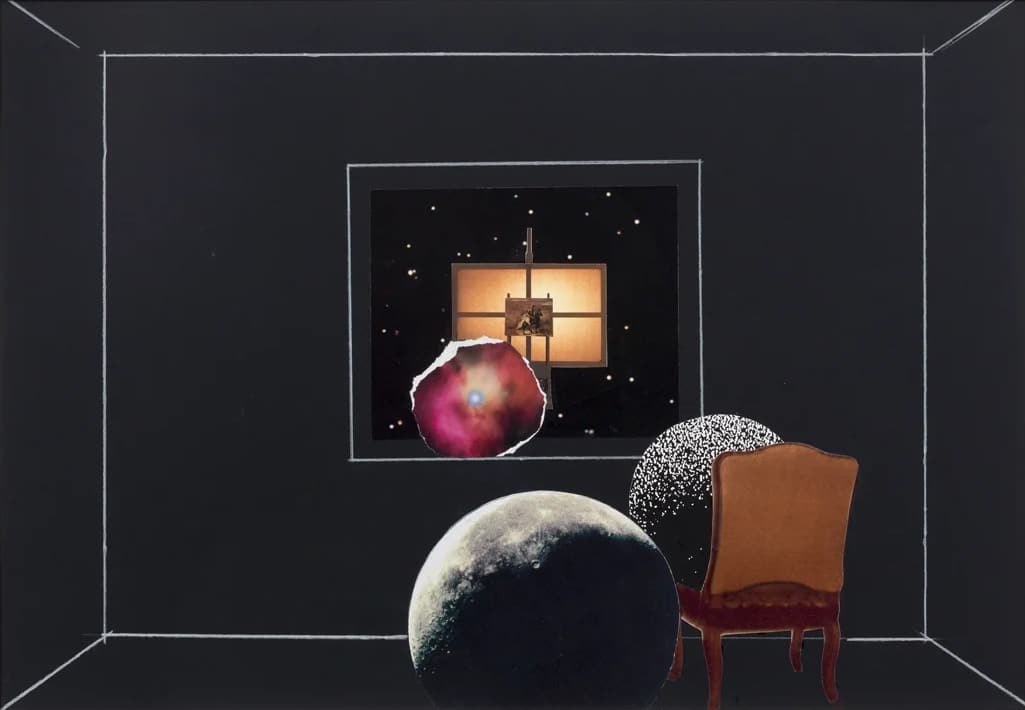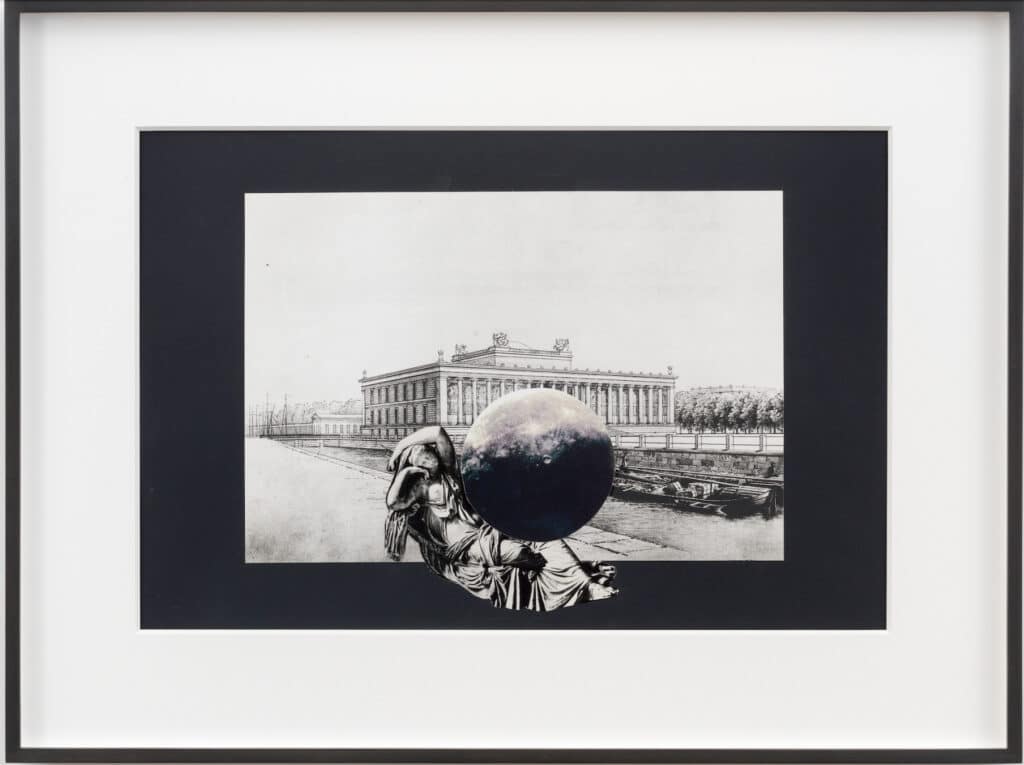No ifs, ands or buts, Art isn’t —and will never be —political.
Fifty years of pushing the envelope and now predilections that harken back almost three centuries. Giulio Paolini tells his story.
For the original essay in Italian, click here.

Plaster casts, plexiglas cases with reflecting side, white plinth, 160 x 110 x 60 cm.
Barbara Bluhm-Kaul and Don Kaul, Chicago, © Giulio Paolini. Photo Adam Reich.
You want an opinion? Here I am to say (or not say) what I believe to believe (or rather, what I believe to be able to say).
I cannot say why, but I have always manifested a degree of embarrassment in considering myself an artist — despite the fact that now everything (or nearly everything) seems to confirm this fact. An enviable career, the titles conferred to me, along with the creative results I have attained, forbid me from having any uncertainty about my position. I am— or at least, I am held to be—an artist.
It might be due to my lack of specialist education, or my propensity for observation over production, or simply my personality… the fact is, above all, I feel more like a spectator than the creator that I am.
The sense of urgency that now fills my being is born from a growing sense of disconcertment that I repeatedly feel when confronted with the besetting and grotesque anxiety expressed by the contemporary Art world for the fate of the world (the real one), and from the consequent necessity for us to take responsibility for this fate, in the name of some blind veneration of Nature. What vanity, and, above all, what an inordinate sense of superiority and omnipotence!
The artist is neither “removed from the world”, nor “in the world”. Artists do not wish to communicate in a direct manner, in real time, foisting their voices upon others; they desire to listen, to capture echoes.
What is art? I think no-one, neither you nor I, can say for sure. One can fix one’s eyes on that sphere for a long time; we aren’t sure if that luminous point we speak of is a star, a planet, or a satellite: that is to say, if its light is raking, natural, or reflected. I speak of Art without being able to speak of it.
It isn’t a matter of simply adjusting one’s objective lens. Imagine if you will: an astronomer sits at his post, when he realizes that the distance that separates him from the stars is the same that now separates him from the Earth. Intent on examining the celestial vault, he wanders in space without the force of gravity, no longer having contact with the world, no longer being able to send messages. Perhaps the telescope has oriented itself in the opposite direction… and what of reality? All that is left of reality for the astronomer is his instrument, precisely that instrument which should allow him to observe reality. “What is art?”, I ask myself again. Paradoxically, the artist is the least suited to providing a response to this question. He certainly knows what Art is, but he cannot formulate a response, except the affirmation— by means of a signature and the date— that a work is “genuine”. But in order to be genuine, a work of Art must forget its author.
At present, Art struggles to find an identity that no-one is able to attribute to it. Rather, our attention is entirely consumed by the elements of a sociology of Art which embodies the veritable original sin committed against the primary essence, the ever-similar and yet ever-different unitary dimension that is the élan of the Art sphere.

White pencil and collage on black paper,46.5 x 66.5 cm.
Private collection, © Giulio Paolini. Photo Adam Reich.
I think some clarity is necessary at this juncture: if on the one hand, we cannot do without art, on the other hand, that “truth” that we call Art can—and must—do without us. In other words, I hereby wish to affirm my opposition to any kind of active participation, to any type of so-called “interaction” that has of late become a kind of complimentary activity to which viewers are urged to subject themselves in order to render the significance of a given work explicit.
In brief, the work of Art cannot make use of any sort of relationship with the viewer, because it cannot conceive the presence—or even the existence— of whoever observes it.
I cannot avoid reading such unfortunate phrases as “making art” “doing politics”, or “making love”… I’ll limit myself to saying that Art makes itself; it doesn’t know what to make of us, and it presents itself without interlocutors and without intermediaries. Its capacity of speech— or its silence— is the furthest possible thing from that blithe idolatrous communication which is practiced at sprawling fairs and festivals.
The “message” of Art is silence. I believe the season for reciting freeing statements such as (yesterday’s) “we are the revolution” or (today’s) “let’s save the planet” has come to close. No-one, therefore, is able to “make art” because only the artwork itself is privy to the secret, immutable key to its existence.
Art isn’t —and can never be —political. But what is that miraculous image that is able to manifest itself while remaining secret, and dazzle the innocent gaze of the observer? We who look elsewhere would like to see only that light, even at the risk of losing our sight. To find ourselves in the impenetrable darkness, behind the curtain on the stage of our times.
That which we see, read, and hear every day constitutes an opaque and deaf barrier that prevents “the unsaid”, or rather the message of art, from shining through.
“Art happens” — says Whistler, quoted by Borges— “Art happens, Art occurs. Art is a small miracle… that in a certain way escapes the organized causality of History. Yes, Art happens, or it doesn’t; this doesn’t depend on the artist.”
The meaning (if one can speak of meaning) of an exhibition does not concern the who or the what, that is, who the artist is, or what the exhibited works mean. An artwork will never, under any circumstances, confer a full understanding of its intricacies. Its artist is merely a first witness, chosen to undertake the delicate mission of safeguarding an unfathomable secret.
The work of Art concerns the how and the why, that is to say the conditions (if there are any, anyway) that determine the opening of the curtain of representation.
It is representation that gives things a name and presents them to figures and characters with its endorsement, for that is the only way in which we may undertake the act of recognition.

Collage on black paper, 33 x 50 cm.
Private collection, © Giulio Paolini. Photo Adam Reich.
Fifty years of artistic activity, in which I have always sought to spot the signals of the new, have paradoxically led me to antiquate my predilections by almost three centuries: today, I find myself agreeing with something that I struggle to identify and summarize for referential purposes. “Et in Arcadia ego”, a panorama of classical ruins, is perhaps the most promising and sharable image for the fascination that such a vision brings to our eyes, eager for comfort and repose.
Earth, sky, characters as hesitant figures amongst so much greatness, which dominates us and relegates us to the complementary role of pilgrims or wayfarers: places possessed by something superior, something inaccessible on our scale.
“When is the present?” asked Rilke, and we ask again: within Time, or without it? Only Art, an exception and witness of eternity, is able to resolve the contradictions of chronology, the illusion of an appearance. But if— as it is said— appearances are deceitful, wherever will we direct our gaze?
The artwork is before us. We see it but we cannot reach it. Gazing into the depths until one forgets the subject is the necessary condition to penetrate the surface behind which we may spot the ever-similar, yet ever-different contour of a yet-unknown figure, which is able to awaken an ancient, invigorated “knowledge” within our memory.
Looking at a painting means seeing it with closed eyes, forgetting it— and therefore being observed— as happens to those who find themselves in normal conditions (for example in a museum or theater) rather than in accidental ones (for example in life).
Distancing ourselves from that which touches us, embarking on a journey without taking a single step. Looking, seeing, forgetting… going out, coming back, the end.
—Giulio Paolini
Translated by Daniel Lowe
